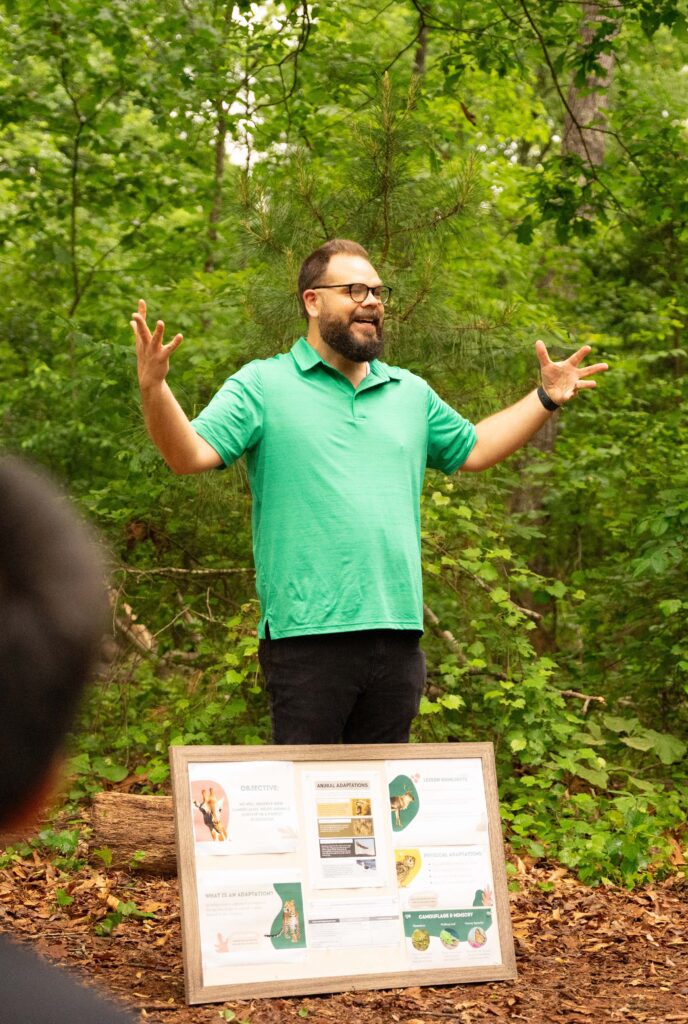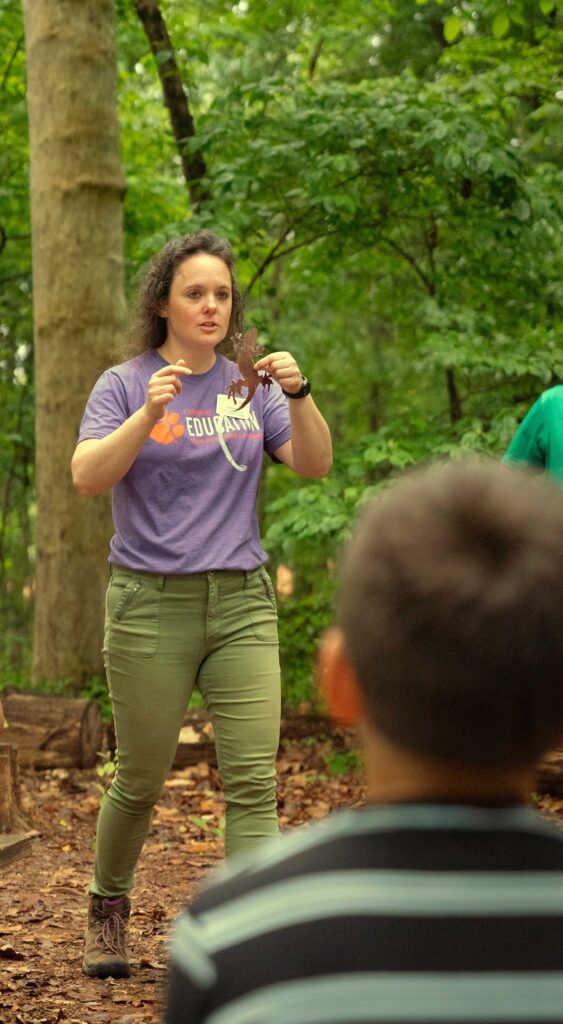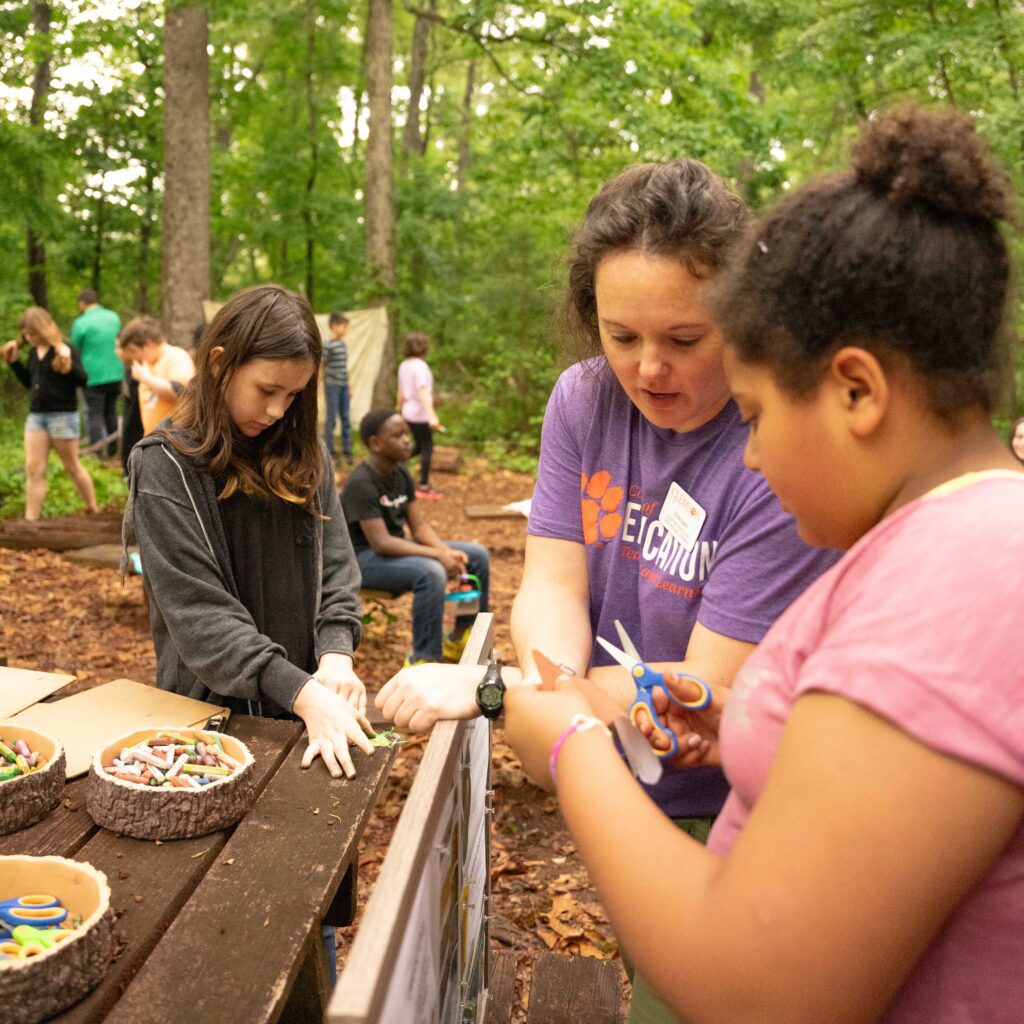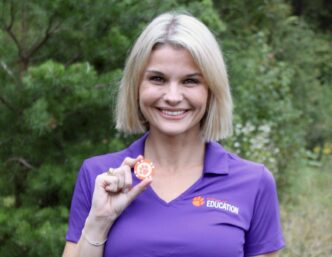Through teaching, research and partnerships, College of Education faculty rethink students’ surroundings and envision a new kind of classroom.
“I bet you can’t find my spider!”
“Dr. Dean! Dr. Dean! Come look for my bug!”
Steph Dean is being pelted with challenges from Central Academy of the Arts students in Kevin Stinehart’s fourth grade class. They’re more amped up and talkative than usual because Dean, Stinehart and the class are outdoors and 200 yards or so from the school, surrounded by trees.
Stinehart said his students get a little more rambunctious when removed from their usual classroom environment, but it’s all worth it to study a subject such as animal habitats away from the classroom and in nature itself. Today’s lesson is on how animals use camouflage in nature to avoid predators and use their surroundings to their advantage.
Stinehart and Dean have challenged the students to create paper cutouts of various animals, color them and then place them in the environment where they would be hardest to find. The ensuing scavenger hunt for paper bugs is as chaotic as it is informative for students, and Dean and Stinehart visit with each student to gauge just how well their paper animals have used camouflage.
“Okay, so that one was right in front of my face, and I didn’t even see it!” Dean says to one student who placed a green, leaf-shaped bug among an overhanging branch of similarly shaped and colored leaves. “Great job! That’s probably the best one I haven’t seen yet.”
Dean, an assistant professor in the Clemson University College of Education, was a kindergarten-through-sixth-grade teacher for 11 years before she took a year off, bought a travel trailer and visited multiple national parks across the country. It was from this experience that she “fell back in love” with education, specifically place-based education. She learned more from reading park signs and talking to rangers than she ever could have from reading about national parks in a book.
She decided to devote the rest of her career to researching the benefits and effective practices in place-based learning and education. She strives to share authentic, meaningful teaching strategies that use local places and phenomena.
Dean and other faculty in the College are incorporating more place-based education in their own teaching and bringing these best practices to districts and schools interested in taking advantage of the benefits of teaching in a forest. Or on the water. Or at a museum. Or anywhere that a lesson can be elevated through a student’s surroundings.
“The physical benefits are obvious, from more vitamin D to even fighting the current wave of short sightedness caused by so many screens,” Dean said, “but the social, emotional and cognitive benefits make learning more meaningful and memorable. The learning is more likely to ‘stick.’”

Outside the classroom window
Stinehart didn’t need to be convinced by Dean to take his students outside. He routinely teaches lessons outside and has been an advocate for play and play-based education during his time working in the School District of Pickens County.

Stinehart is aware of how easy it is as a teacher and as a parent to move from one perfectly controlled, air-conditioned room to another–home to car to classroom and back again–and he sees the effect it has on his students and his own family. Stinehart’s daughter was one of the students in his fourth-grade class, so he wants to make every effort to keep the connection between his students and the outside world as alive as possible.
“Place-based education is valuable because if we want students to take care of the world, they really need to have a connection with where they are,” Stinehart said. “If they understand what’s here they will care about it, and then they can expand that care to oceans or other countries and continents around the world.”
Dean said that the pressures of curriculum can often make teachers feel boxed in and confined to the classroom, so a big hurdle to place-based education is finding ways to incorporate it. She said that concerns about safety and weather, especially in areas of the country where rain is constant, are certainly factors that are harder to control, but issues related to teacher confidence and self-efficacy are where faculty can help.
Dean is working with districts to make recommendations to educators in the use of place-based education and how to integrate outdoor learning with the state’s academic standards.
“We really just need to add more tools to teachers’ toolboxes, or simply let them know what’s there already,” Dean said.

Stinehart said the key to crafting a great lesson that takes advantage of place is seeing what standards can apply in the Upstate. Weathering and erosion happen everywhere, so he took students outside so they could look for examples of them. The same applied to life cycles of plants and animals shown in observations of school gardens or the adoption of a tree that students can observe season to season.
Stinehart wouldn’t put forth the extra effort to augment lessons with outdoor learning if he didn’t see tangible learning benefits and the less obvious social and emotional improvements in each of his students. He can point to better retention of material in a lesson taught outside versus one taught traditionally. Outdoor learning also fosters more collaboration and communication among students, so behavioral benefits in the short and long term are numerous.
The camouflage lesson took place near the end of the school year for Stinehart’s students, and while he had to issue the occasional reminder to students to stay on task, he was largely hands off outside of setting the stage for the lesson and circling up with students to review what they had learned. The lesson was as far removed from slow-paced, didactic lecturing as teaching could get, and that, for Stinehart, was the goal.
“They’re engaging all five senses and taking what’s abstract and making it into a memory,” Stinehart said. “I don’t have to direct that, and I shouldn’t; my role at this point in the year is to be a facilitator.”
Equipping tomorrow’s teachers
Every student in the College of Education is familiar with the meta experience of a faculty member exploring a teaching concept and simultaneously using the very same concept to instruct them. Before a Spring 2024 outing to the Clemson Outdoor Lab for class, Mya Molina was not aware of place-based learning. By the end of the day, she engaged in place-based education herself and learned about how to use it with her future students.

“It did not feel as though we were actually learning like in a traditional classroom,” Molina said. “It brought out a different side of learning I have never experienced, and I felt like things started to connect better when actually experiencing and talking about place-based education.”
Koti Hubbard, lecturer in the Department of Teaching and Learning from which Dean also hails, brought one of her early childhood education classes to the Outdoor Lab along with Dean. Hubbard had been a proponent of place-based education before the experience, but the day’s activities and her students’ reactions turned her into a true believer.
For the Outdoor Lab excursion, Hubbard modeled an integrated social studies and science lesson centered around the concept of water. She designed a lesson highlighting need and access to water for different societies and the fact that billions of people lack access to clean drinking water. Students worked in pairs to design a water filter to purify “dirty” lake water, and Hubbard provided natural and unnatural materials such as pebbles, sand and cotton balls that students could utilize in addition to those found in nature.
Students tested their filters, made adjustments and analyzed its quality using testing strips. Hubbard said the outdoor setting significantly enhanced the learning experience, making the lesson more authentic and engaging for the students. The hands-on, real-world context of the Outdoor Lab provided a dynamic environment that deepened students’ understanding and motivation to learn.
“I have come to appreciate the full value of place-based education in enhancing students’ motivation to learn, providing equitable outdoor spaces for children and boosting students’ mental health and well-being,” Hubbard said. “The approach effectively integrates inquiry-based learning and play, both of which are essential components of early childhood education. The approach obviously works just as well for adults.”
Molina wants to teach either pre-kindergarten or second grade, and the Outdoor Lab experience made her immediately start to think about which lessons can be translated to the outdoors or a specific place. She struggled with science and social studies in school, and she believes that a different setting might help kids such as her or at least allow them to see the concept’s value in a new light.
“Using the local environment and building off of it to incorporate STEM and social studies concepts was really clever,” Molina said. “Giving students the opportunity to use a different outlet to connect with their local community and environment is important and helps them grow outside of education.”
Embedding research
While Hubbard focused on water, Dean lead a science lesson using a classic “egg drop” exercise that introduced concepts such as physics and materials science. Students were tasked with using provided materials and those in the environment to build devices that safely transfer a dropped egg from the air to the ground.

While Dean does have a passing interest in the best way to surround an egg with pinecones and rubber bands, she also had an ulterior motive for the Outdoor Lab experience. She was teaching about place-based education, using it and then surveying the students to contribute to her research on the topic. There’s fun and activity and dirt under fingernails, but there’s also a long-term research goal in mind that will contribute to scholarship on the topic.
“I want to really understand the affect these types of experiences have on students and on the teachers using them,” Dean said. “That’s how we not only effect some positive change in schools around us but also set the standard informed by data about how and why to use place-based education.”
Dean’s visit with Stinehart’s class didn’t just boil down to grabbing some art supplies and trekking into the woods; the lesson took planning and coordination between the two to ensure it would be fun and informative while conforming to state science standards.
The pair emailed back and forth matching science standards to outdoor teaching that incorporated local wildlife and the natural environment. They didn’t choose animals that existed on the other side of the world, but those that could actually be found behind Central Academy.

Dean introduced the lesson and set up the phenomena, while Stinehart gave instructions that he knew would register with the students he had gotten to know so well over the course of a year. Both engaged with the students during the “animal hunt,” but Stinehart closed out the lesson, drawing conclusions that connected to the learning.
“You can see the difference in learning,” Stinehart said. “They’re noticing how the forest smells different each season. They see it. Their tactile senses get involved. It takes something that was just a lesson and makes it a memory, not just something they are memorizing for a quiz or a test.”
Dean is currently working on a scoping review that synthesizes empirical research related to place-based education in a rural setting. She is collaborating with Phillip Grant, assistant professor in the College of Education, on this project with the purpose of examining the intersection between rurality and place-based learning.
Additionally, Dean is working with Julianne Wenner, associate professor in the College, on another project that investigates rural outdoor science education. Wenner has used a grant from the National Science Foundation to examine how families could reframe what constitutes science in the home and develop an instrument that will help educators better partner with families when it comes to science education. Wenner ultimately wants schools to recognize, honor and build on students’ home science experiences to improve their science education.
Dean and other College of Education faculty are interested in exploring ways that educators engage in place-based pedagogies to teach all subjects in the natural environment. Fortunately for Clemson faculty, their workplace is not lacking for nature or spaces in which to teach outdoors.
“Clemson is really well situated to engage in place-based education given our location in the Upstate and the incredible ecosystems, geography and culture we have here,” Dean said. “The College of Education is increasingly working towards partnering with schools to support teachers in their efforts to get outside and teach.”







